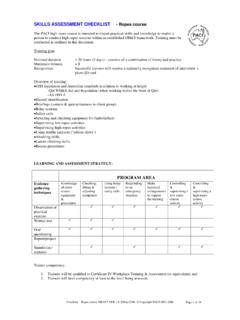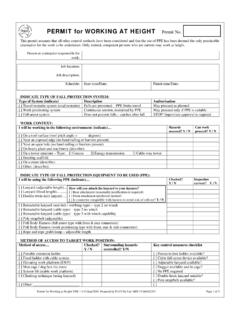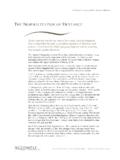Transcription of Rogers v Whitaker - PACI
1 Rogers v Whitaker [1992] HCA 58; (1992) 175 CLR 479. (19 November 1992). high court OF australia . Rogers v. Whitaker [1992] HCA 58; (1992) 175 CLR 479. 92/045. Negligence high court OF australia . Mason CJ(1), Brennan(1), Dawson(1), Toohey(1), Gaudron and(2), McHugh(1) JJ. CATCHWORDS. Negligence - Breach of duty - Medical practitioner - Duty to warn of possibility of adverse effect of proposed treatment - Extent of duty. HEARING. CANBERRA, 1992, April 28, November 19. 19:11:1992. APPEAL from the Supreme court of New South Wales. Maree Lynette Whitaker , who had for many years been almost totally blind in her right eye, consulted Christopher Rogers , an ophthalmic surgeon, who advised her that an operation on the eye would not only improve its appearance but would probably restore significant sight to it.
2 Whitaker agreed to undergo surgery. After the operation there was no improvement to the right eye, and Whitaker developed inflammation in the left eye which led to loss of sight in that eye. She sued Rogers in the Supreme court of New South Wales for damages for negligence. Campbell J found Rogers liable in that he had failed to warn Whitaker that, as a result of the surgery, she might develop a condition known as sympathetic ophthalmia in her left eye. He awarded damages of $808, An appeal by Rogers to the court of Appeal (Mahoney, Priestly and Handley JJA) was dismissed Rogers v Whitaker (1991) 23 NSWLR 600.
3 He then appealed, by special leave, to the high court . DECISION. MASON , BRENNAN, DAWSON, TOOHEY AND McHUGH JJ. The appellant, Christopher Rogers , is an ophthalmic surgeon. The respondent, Maree Lynette Whitaker , was a patient of the appellant who became almost totally blind after he had conducted surgery upon her right eye. The respondent commenced proceedings against the appellant for negligence in the Supreme court of New South Wales and obtained judgment in the amount of $808, After an unsuccessful appeal to the court of Appeal of New South Wales ((1) (1991) 23 NSWLR 600), the appellant now appeals to this court .
4 2. There is no question that the appellant conducted the operation with the required skill and care. The basis upon which the trial judge, Campbell J., found the appellant liable was that he had failed to warn the respondent that, as a result of surgery on her right eye, she might develop a condition known as sympathetic ophthalmia in her left eye. The development of this condition after the operation and the consequent loss of sight in her left eye were particularly devastating for the respondent as she had been almost totally blind in her right eye since a penetrating injury to it at the age of nine.
5 Despite this early misfortune, she had continued to lead a substantially normal life: completing her schooling, entering the workforce, marrying and raising a family. In 1983, nearly forty years after the initial injury to her right eye and in preparation for a return to the paid workforce after a three year period during which she had looked after her injured son, the respondent decided to have an eye examination. Her general practitioner referred her to Dr Cohen, an ophthalmic surgeon, who prescribed reading glasses and referred her to the appellant for possible surgery on her right eye.
6 3. The respondent did not follow up the referral until 22 May 1984 when she was examined by the appellant for the first time. The appellant advised her that an operation on the right eye would not only improve its appearance, by removing scar tissue, but would probably restore significant sight to that eye. At a second consultation approximately three weeks later, the respondent agreed to submit to surgery. The surgical procedure was carried out on 1 August 1984. After the operation, it appeared that there had been no improvement in the right eye but, more importantly, the respondent developed inflammation in the left eye as an element of sympathetic ophthalmia.
7 Evidence at the trial was that this condition occurred once in approximately 14,000 such procedures, although there was also evidence that the chance of occurrence was slightly greater when, as here, there had been an earlier penetrating injury to the eye operated upon. The condition does not always lead to loss of vision but, in this case, the respondent ultimately lost all sight in the left eye. As the sight in her right eye had not been restored in any degree by the surgery, the respondent was thus almost totally blind. 4. In the proceedings commenced by the respondent, numerous heads of negligence were alleged.
8 Campbell J. rejected all save the allegation that the appellant's failure to warn of the risk of sympathetic ophthalmia was negligent and resulted in the respondent's condition. While his Honour was not satisfied that proper medical practice required that the appellant warn the respondent of the risk of sympathetic ophthalmia if she expressed no desire for information, he concluded that a warning was necessary in the light of her desire for such relevant information. The court of Appeal (Mahoney, Priestley and Handley ) dismissed all grounds of the appellant's appeal from the judgment of $808, on both liability and damages; the court also dismissed a cross-appeal by the respondent on the question of general damages.
9 The respondent does not pursue the latter issue in this court but the appellant has appealed on the questions of breach of duty and causation. Breach of duty 5. Neither before the court of Appeal nor before this court was there any dispute as to the existence of a duty of care on the part of the appellant to the respondent. The law imposes on a medical practitioner a duty to exercise reasonable care and skill in the provision of professional advice and treatment. That duty is a "single comprehensive duty covering all the ways in which a doctor is called upon to exercise his skill and judgment".
10 ((2) Sidaway v. Governors of Bethlem Royal Hospital [1985] UKHL 1; (1985) AC 871, per Lord Diplock at p 893); it extends to the examination, diagnosis and treatment of the patient and the provision of information in an appropriate case ((3) Gover v. South australia (1985) 39 SASR 543, at p 551.). It is of course necessary to give content to the duty in the given case. 6. The standard of reasonable care and skill required is that of the ordinary skilled person exercising and professing to have that special skill ((4) Bolam v. Friern Hospital Management Committee (1957) 1 WLR 582, at p 586; see also Whitehouse v.)





